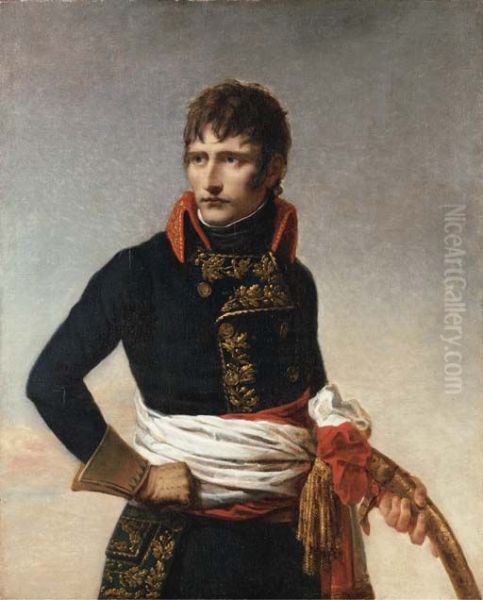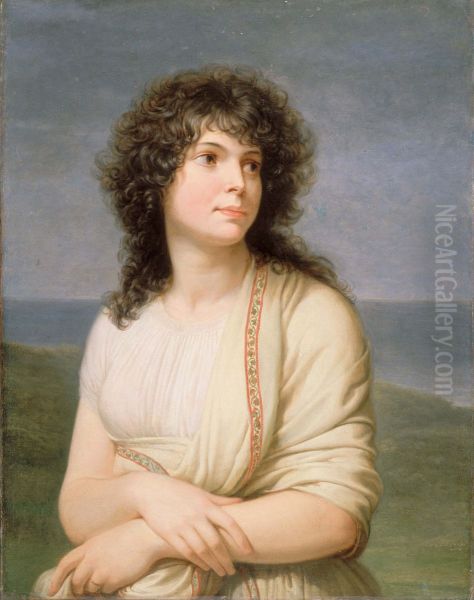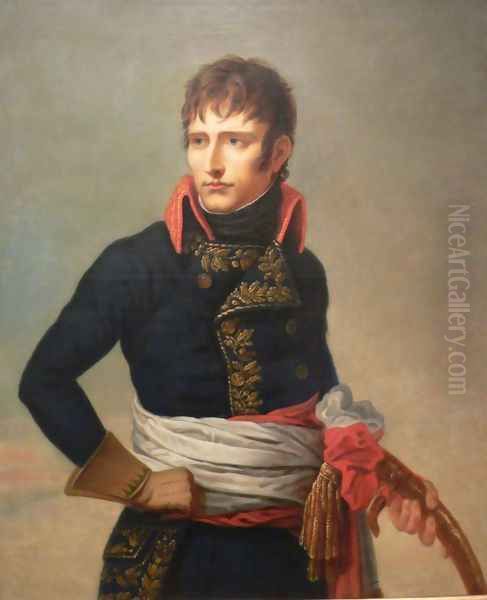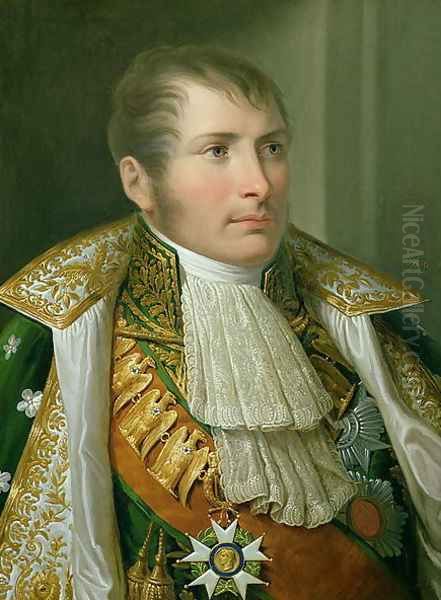
Andrea Appiani, a name synonymous with the zenith of Italian Neoclassicism, stands as a pivotal figure in the art history of the late 18th and early 19th centuries. His life and work offer a fascinating glimpse into a period of profound political and cultural transformation in Europe, particularly in Italy under the sway of Napoleonic influence. Appiani's artistic journey, from his early training in Milan to his celebrated status as Napoleon's court painter, is a testament to his exceptional talent, his adaptability, and his deep engagement with the classical ideals that defined his era.
Early Life and Artistic Formation
Born in Milan on May 31, 1754, Andrea Appiani hailed from a family of noble lineage, though one that did not possess substantial wealth. This background perhaps instilled in him a drive and ambition that would later characterize his career. His artistic inclinations were evident from a young age, leading him to pursue formal training. His initial tutelage was under the guidance of Carlo Maria Giudici, a painter who likely provided him with the foundational skills necessary for any aspiring artist of the time.
Appiani's thirst for knowledge and mastery led him to further refine his skills. He joined the class of the fresco painter Antonio de' Giorgi, where he would have learned the complex techniques of mural painting, a medium in which he would later excel. His education was not limited to practical application; he also dedicated himself to the study of human anatomy, essential for the accurate and idealized depiction of the human form central to Neoclassical aesthetics. This he pursued at the Ospedale Maggiore in Milan, alongside oil painting techniques, likely through copying Old Masters at the esteemed Pinacoteca Ambrosiana. The Ambrosiana, with its rich collection, would have exposed him to the works of Renaissance giants like Leonardo da Vinci and Bernardino Luini, whose Lombard grace undoubtedly left an impression.

His studies also extended to the private academy of painter Martin Knoller and the sculptor Gaetano Monti, further broadening his artistic horizons. During this formative period, Appiani immersed himself in the study of classical antiquity, drawing inspiration from Roman sculpture and the Renaissance masters who had themselves revived classical forms, such as Raphael and Correggio. The influence of earlier Neoclassical proponents like Anton Raphael Mengs, who had championed a return to classical purity, would also have been part of the intellectual and artistic currents shaping young Appiani.
The Ascent of a Neoclassical Master
Appiani's career began to flourish as he absorbed these diverse influences and synthesized them into a distinctive style. He was particularly drawn to the grace and elegance of Correggio, whose soft sfumato and sensuous figures offered a counterpoint to the sterner, more archaeological Neoclassicism championed by some of his contemporaries. Appiani's Neoclassicism was imbued with a certain Lombard charm and a sensitivity to color and light that set his work apart.
He initially gained recognition for his decorative frescoes and mythological scenes. An early significant commission was for frescoes in the church of Santa Maria presso San Celso in Milan, executed around 1792-1795. These works, depicting scenes from the life of Moses, demonstrated his mastery of large-scale composition and his ability to convey narrative with clarity and elegance. His skill in rendering the human form, honed through his anatomical studies, was evident in the graceful, idealized figures that populated these religious scenes.
During this period, he also undertook study trips to Rome, Naples, Parma, and Bologna. These journeys were crucial for any artist seeking to steep themselves in the classical tradition and the High Renaissance. In Rome, he would have encountered the masterpieces of antiquity firsthand, as well as the works of Raphael and Michelangelo. Parma would have offered a deeper immersion in the art of Correggio, while Bologna would have exposed him to the Carracci and the Bolognese school's classical revival. These experiences undoubtedly enriched his artistic vocabulary and solidified his commitment to Neoclassical principles.
The Napoleonic Era: Court Painter and Propagandist
The arrival of Napoleon Bonaparte in Italy marked a turning point in Appiani's career. Napoleon, a keen patron of the arts and aware of their power for propaganda, recognized Appiani's talent. In 1796, when Napoleon entered Milan, Appiani was already a respected artist. His skills were quickly enlisted to glorify the French general and his regime. He was appointed "Commissario Superiore" by Napoleon, tasked with selecting Italian artworks to be sent to Paris, a role that placed him at the center of the artistic politics of the time.

Appiani became, in essence, the official painter of the Napoleonic regime in Italy. He was commissioned to create numerous portraits of Napoleon, his family, and prominent members of his court. These portraits were instrumental in crafting the public image of the new rulers, presenting them with an air of authority, dignity, and classical virtue. One of his most famous portraits is Napoleon I of France, now housed in the Kunsthistorisches Museum in Vienna, which captures the emperor in a regal yet thoughtful pose. Another notable work, Bonaparte à Milan, in the Montreal Museum of Fine Arts, commemorates Napoleon's presence in the city that became a hub of his Italian dominion.
Perhaps his most ambitious projects for Napoleon were the monumental frescoes in the Palazzo Reale (Royal Palace) in Milan. Here, Appiani created a series of allegorical and historical scenes celebrating Napoleon's achievements, known as the Fasti di Napoleone (The Deeds of Napoleon). The centerpiece of this decorative scheme was the Apotheosis of Napoleon, a grand ceiling painting in the Sala delle Cariatidi, depicting Napoleon as a deified classical hero. These works, executed with remarkable skill and a sophisticated understanding of Neoclassical allegory, cemented Appiani's reputation as the leading painter in Napoleonic Italy. He skillfully blended historical events with mythological symbolism, elevating Napoleon to the status of a modern Caesar or Alexander.
Mastery in Portraiture
While his monumental frescoes were grand public statements, Appiani also excelled in the more intimate genre of portraiture. His portraits are characterized by their elegance, psychological insight, and refined technique. He possessed a remarkable ability to capture not only a sitter's likeness but also their personality and social standing. His female portraits, in particular, are renowned for their grace and charm.
A prime example is the Portrait de Madame Hamelin (Fortunée Hamelin), painted around 1798 and now in a Parisian museum (often cited as Musée Carnavalet or Jacquemart-André). This work showcases Appiani's delicate handling of paint, his subtle use of color, and his ability to convey the sitter's fashionable allure and intelligence. He often employed a soft, diffused light that flattered his subjects and lent an air of gentle romanticism to his otherwise Neoclassical compositions. This subtle infusion of a more tender sensibility distinguished his work from the more austere Neoclassicism of some of his French contemporaries, like Jacques-Louis David, though David's influence on the formal aspects of Neoclassicism was undeniable across Europe.

Appiani's sitters included not only the Napoleonic elite but also members of the Milanese aristocracy and intellectual circles. His friendship with the influential poet Giuseppe Parini, a leading figure of the Italian Enlightenment and a proponent of Neoclassical ideals in literature, was significant. Parini's aesthetic theories likely resonated with Appiani and may have further guided his artistic direction. This connection highlights the interdisciplinary nature of the Neoclassical movement, where literature, art, and philosophy often intersected.
Frescoes and Monumental Works Beyond Napoleon
Even before his extensive work for Napoleon, Appiani had established himself as a master of fresco. His work in the church of Santa Maria presso San Celso has already been mentioned. He also executed significant decorative schemes in private residences and other public buildings. The cupola of Santa Maria dei Miracoli presso San Celso, with its Four Evangelists and Doctors of the Church, further showcased his command of this demanding medium.
One of his most celebrated non-Napoleonic monumental works is the fresco Parnassus (or Il Parnaso) in the dining room (Sala da Pranzo) of the Royal Villa of Milan (Villa Reale, now the Galleria d'Arte Moderna). Executed around 1811, this large fresco depicts Apollo and the Muses on Mount Parnassus, a quintessential Neoclassical theme celebrating the arts and classical culture. The composition is harmonious, the figures are gracefully rendered, and the overall effect is one of serene, idealized beauty. This work stands as a testament to Appiani's enduring commitment to classical themes even amidst the political turmoil of his time.
Other notable frescoes include those in the Villa Reale in Monza, such as L'Amore e la Storia (Cupid and History), demonstrating his versatility in adapting classical mythology to decorative contexts. His ability to integrate painted figures with architectural settings was a hallmark of his skill in fresco. He was adept at creating illusions of space and light, making his murals vibrant and engaging.
Artistic Style and Innovations
Andrea Appiani's style is a sophisticated blend of Neoclassical principles with a distinctly Lombard sensibility. His drawing was precise and elegant, reflecting the Neoclassical emphasis on line (disegno). His compositions were balanced and harmonious, often drawing on classical prototypes. However, his use of color was richer and his handling of light and shadow softer than that of many stricter Neoclassicists. This gave his works a warmth and accessibility that appealed to a wide audience.

He was particularly influenced by the Lombard Renaissance tradition, especially the works of Leonardo da Vinci and Correggio. From Leonardo, he may have absorbed the use of sfumato (soft, hazy transitions between colors and tones), and from Correggio, a certain grace, sensuality, and mastery of light. This fusion of High Renaissance grace with Neoclassical structure was a key element of his unique style. He managed to avoid the coldness and rigidity that sometimes characterized Neoclassical art, infusing his works with a gentle vitality.
While firmly rooted in Neoclassicism, some art historians detect in Appiani's later works, particularly his portraits, a subtle leaning towards the emerging Romantic sensibility. This can be seen in the increased emphasis on individual psychology, the softer modeling, and the more emotive use of light. This transitional quality makes his work particularly interesting, bridging the gap between the Age of Reason and the Age of Emotion. His Rape of Europa, an earlier mythological painting, already showed a dynamic composition and emotional intensity that hinted at this capacity.
Influences and Contemporaries
Appiani operated within a vibrant artistic milieu. In Milan, he was a leading figure, but he was also aware of broader European trends. His contemporaries in Italy included other notable Neoclassical painters such as Vincenzo Camuccini in Rome and Pelagio Palagi, who worked in various Italian cities. While Appiani was undoubtedly the preeminent painter in Lombardy during the Napoleonic era, he faced competition from artists like Giuseppe Bossi, who was also a significant figure in Milanese artistic circles and secretary of the Brera Academy, and Francesco Corneliani.
The influence of French Neoclassicism, particularly the work of Jacques-Louis David, was pervasive throughout Europe. While Appiani's style was softer and more lyrical than David's, he would have been aware of the French master's powerful compositions and his role in shaping the visual language of the French Revolution and the Napoleonic Empire. The sculptor Antonio Canova was another towering figure of Italian Neoclassicism, and his idealized marble figures shared a common aesthetic ground with Appiani's painted heroes and gods. Angelica Kauffman, though active earlier and in different centers, also represented a graceful, less severe form of Neoclassicism that might have found resonance with Appiani's approach.
Appiani, in turn, influenced a subsequent generation of artists in Milan. He taught at the Brera Academy, and his style left its mark on his students. Although Romanticism would soon become the dominant artistic movement, Appiani's legacy as a master of Neoclassical grace and technical brilliance endured. Francesco Hayez, who would become a leading figure of Italian Romanticism, began his career in a Neoclassical vein and would have been well aware of Appiani's achievements.
Later Years, Decline, and Legacy
The fall of Napoleon in 1814-1815 had a devastating impact on Appiani's fortunes. With the collapse of the Napoleonic Kingdom of Italy and the restoration of Austrian rule in Lombardy, Appiani lost his prestigious position as court painter and the generous pension that came with it. His close association with the fallen regime made him politically suspect in the eyes of the new rulers.
Despite his artistic achievements, he found himself in increasingly dire financial straits. In 1813, he suffered a stroke, which significantly hampered his ability to work. A second stroke further debilitated him. Andrea Appiani died in Milan on November 8, 1817, at the age of 63, in relative poverty. It was a somber end for an artist who had once been at the pinnacle of artistic success and official favor.
Despite the hardships of his final years, Appiani's artistic legacy was secure. He left behind a substantial body of work, including frescoes, oil paintings, and drawings, which attest to his skill and artistic vision. His contributions to the Brera Academy, including donations of his works, helped to solidify its collections. His paintings continued to be admired for their elegance, technical mastery, and their embodiment of Neoclassical ideals. He is remembered as one of Italy's foremost Neoclassical painters, a master of graceful line, harmonious composition, and subtle coloration. His ability to adapt Neoclassical principles to various genres, from monumental frescoes to intimate portraits, demonstrates his versatility and artistic intelligence.
Controversies and Anecdotes
Like many figures who lived through turbulent political times, Appiani's life was not without its share of complexities. His close association with Napoleon, while bringing him fame and fortune, also tied his fate to that of the Emperor. This relationship could be seen as both an opportunity and a compromise, depending on one's perspective on the Napoleonic regime.
There are some accounts, though not always definitively substantiated, suggesting Appiani's involvement in more clandestine political activities. One source mentions an accusation of him being involved in a plot to organize an armed revolt in Milan, aiming for a violent seizure of power. Such activities, if true, would paint a picture of an artist deeply engaged in the political currents of his time, perhaps beyond the role of a mere court painter.
His artistic style, with its blend of Neoclassical rigor and a softer, almost proto-Romantic sensibility, occasionally sparked debate among critics who preferred a more austere or archaeologically "correct" form of Neoclassicism. However, it is precisely this nuanced approach that gives his work its enduring appeal.
The friendship with Giuseppe Parini is a well-documented and significant aspect of his life. Parini's influence on Appiani's adoption of Neoclassical aesthetics is often noted, highlighting the fruitful exchange between literary and visual arts during this period. Parini's odes, with their classical allusions and refined language, provided an intellectual framework that complemented Appiani's visual style.
Conclusion: An Enduring Figure in Art History
Andrea Appiani remains a significant figure in the history of European art. As a leading proponent of Neoclassicism in Italy, he created works of enduring beauty and elegance. His career reflects the profound impact of the Napoleonic era on Italian art and culture, and his paintings provide a vivid visual record of this transformative period. From his masterful frescoes that adorned palaces and churches to his sensitive portraits that captured the likenesses of emperors and aristocrats, Appiani demonstrated a remarkable artistic range and technical skill.
His ability to fuse classical ideals with a Lombard grace and a subtle psychological depth ensured his prominence in his own time and his lasting reputation. Though his final years were marked by hardship, the brilliance of his artistic achievements continues to shine, securing his place as "the painter of the Graces" and a master of Italian Neoclassicism. His works are preserved in major museums and collections across the world, allowing contemporary audiences to appreciate the refined artistry of Andrea Appiani, a painter who skillfully navigated the currents of art and power at a pivotal moment in European history.